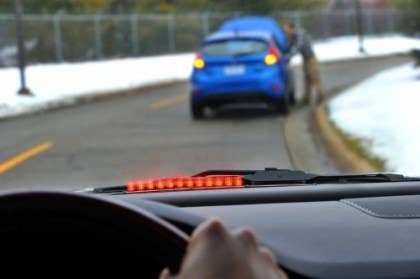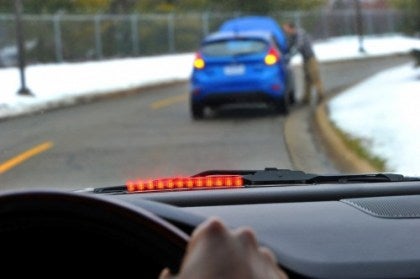Ford To Make Roads Safer By Networking Cars Together Wirelessly (Video)

Share
With auto technology getting more and more advanced every day, we are often looking to our cars to do the mundane things for us, like paying attention to the road. Ford just doubled their investment in Intelligent Vehicle Research, looking to develop cars that can alert their drivers to danger. These enhancements will use WiFi technology to communicate with nearby vehicles and keep drivers aware of potential dangers that are going on around them, even if they’re not in the driver’s field of vision. For example, you could be notified of a car driving recklessly that is still far away but will soon cross dangerously into your path. Your car would flash warning signals and make beeping noises, but you would still be responsible for driving. You can get a taste of how Ford’s IVR could help save lives with the demonstrations presented in the video below. Their plan is to have these augmented cars road-ready in the next few years. With these advancements coming from a major company like Ford, Americans should have an easier time accepting the idea of their car being alert and capable of thinking on its own - something that most people are a bit apprehensive about.
Recently, we took a look at the SAfe Road TRains for the Envrionment (SARTRE) automated driving technology. While that technology will focus on the cars being able to actually drive themselves, this concept from Ford won’t ever actually take over your car’s maneuvers, just alert you to dangers that you would be otherwise unaware of. According to the National Highway Traffic Safety Administration (NHTSA), Ford's technology could help to reduce as many as 4,336,000 accidents annually, as 81 percent of all light-vehicle crashes involving unimpaired drivers are due to human error. It will do this by allowing capable vehicles to communicate with each other on a secure channel about current safety hazards present on the road.
Features similar to this called “Collision Avoidance” are already available on the new Ford Taurus, Volvo XC60, V70, XC70 and S80 and Mercedes-Benz E and S Class but they rely on radar-based systems which are only capable of recognizing hazards in a direct line of sight. Ford’s new WiFi-based system will allow for full range, 360-degree detection of potential dangers, even if they are currently obstructed from the driver’s field of vision. This is a great advancement by Ford, but in reality nothing revolutionary.
An example of this would be if a car that is 15 cars ahead of you on a fast moving, crowded highway brakes suddenly it might not be visible to you. The system will alert you to the fact that traffic will be slowing down dramatically any second so you will have sufficient time to take the appropriate precautions. Other functions include notifying you at intersections if a car approaching at the same time as you shows no signs of slowing down for a red light.
Be Part of the Future
Sign up to receive top stories about groundbreaking technologies and visionary thinkers from SingularityHub.


Paul Mascarenas, vice president, Research and Advanced Engineering and chief technical officer has said that:
"The day is not far off when our vehicles will operate like mobile devices with four wheels, constantly exchanging information and communicating with our environment to do things like shorten commute times, improve fuel economy and generally help us more easily navigate life on the road."
With cars communicating so effectively there is an almost unlimited number of ways the system could potentially be used to enhance your driving experience. Some ways that it could possibly be implemented are in a sort of "post-accident autopsy" where the movements and maneuvers of the car prior to the crash had been recorded to better understand the cause of the accident, even if the drivers didn't make it. With this technology being used on the black box of airplanes it is quite surprising that this has not been implemented yet for automobiles as well. This technology from Ford could be the perfect vessel to introduce black box-like functionality to cars.
Ford currently plans for a 20-member team of both scientists and engineers to undertake the research and testing required to make these cars a reality. They also plan to partner with other automakers and the federal government along with local and county road commissions to make sure all future vehicles equipped with this technology will speak compatible protocols. Ford will contribute two prototype Ford Taurus sedans as a part of the first ever government sponsored driving clinics starting in the summer of 2011. Their current goal is to develop inter-operability standards by 2013. Major technology hubs around the country will also be getting exclusive looks at these new cars at auto shows and government demonstrations.
Since social and legal barriers still exist before automated driving decision systems can be approved, it’s important to expose more people to the potential benefits of this coming technology before it is ready. Due to the gradual nature of social and legal change, fully automated driving is unlikely to come all at once. Ford is providing a compromise, which really proves that automated driving becoming a reality will be a long, arduous, uphill battle. Looking towards examples like the Google Robot Car, which has already logged in 140,000 miles of on road time, we can see a lot of ways for these technologies to complement each other. Google seems to have the automated driving part down and Ford aims to able to keep them all from crashing into each other. There is lots of good stuff coming from both sides and if they both work towards a common goal it will be a great example of the whole being greater than the sum of its parts.
[image credit: CBS]
[video credit: Ford]
[source: Ford]
Related Articles

This Light-Powered AI Chip Is 100x Faster Than a Top Nvidia GPU

Hugging Face Says AI Models With Reasoning Use 30x More Energy on Average

Study: AI Chatbots Choose Friends Just Like Humans Do
What we’re reading
